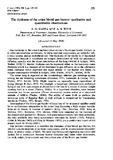The thickness of avian blood-gas barrier: qualitative and quantitative observations.

View/
Date
1982Author
Maina, JN
King, AS
Type
ArticleLanguage
enMetadata
Show full item recordAbstract
Gas exchange in the avian lung takes place across a blood-gas barrier formed, as
in other air-breathing vertebrates, by three essential components, an epithelial cell,
a basal lamina, and an endothelial cell. The thickness of the barrier is of functional
importance because it constitutes an integral determinant of both the pulmonary
diffusing capacity and the tissue metabolism of the lung (Weibel & Knight, 1964;
Weibel, 1970/71). Barrier thickness can be expressed either as the harmonic mean
thickness which is a measure of the resistance to gas diffusion, or as the arithmetic
mean thickness which expresses the tissue density of the barrier and hence its
oxygen consumption (Weibel & Knight, 1964; Weibel, 1970/71; Weibel, 1973).
The avian lung is regarded as the outstandingly efficient gas exchange system
among the air breathing vertebrates (Duncker, 1971; Lasiewski & Calder, 1971;
Weibel, 1973; Scheid, 1979). Flight requires an unusually large expenditure of
energy (Berger & Hart, 1974). For example, a budgerigar (Melopsittacus undulatus)
flying at sea level uses oxygen at almost twice the rate of a mouse of similar weight
running hard in a wheel (Tucker, 1968a). In a hypobaric chamber, mice become
comatose but house sparrows (Passer domesticus) remain active at a simulated
altitude of 6100 m (Tucker, 1968b). The ability of some birds to perform the
strenuous work of flapping flight at high altitude is exceptional by mammalian
standards (Tucker, 1972; Berger, 1974).
Attenuation of the blood-gas barrier without loss of its structural stability could
be an evolutionary adaptation in the avian lung favouring a high oxygen transfer
from air to blood. A number of authors (King, 1966; Duncker, 1970; King &
Molony, 1971; Bouverot, 1978; Meban, 1980) have remarked on the thinness of
the avian blood-gas barrier. However, few actual measurements have been published,
the only available data being approximate estimates by Schulz (1962), Policard,
Collet & Martin (1962) and King & Molony (1971), and a preliminary report of the
present work by Maina (1981).
URI
http://www.ncbi.nlm.nih.gov/pmc/articles/PMC1167892/pdf/janat00219-0138.pdfhttp://erepository.uonbi.ac.ke:8080/xmlui/handle/123456789/49712
Citation
J Anat. 1982 May;134(Pt 3):553-62Publisher
Department of Veterinary Anatomy, University of Liverpool, Department of Veterinary Anatomy, University of Nairobi
